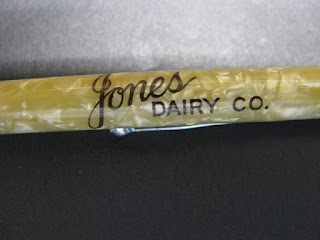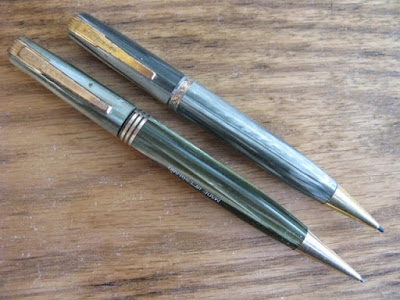Although I have another Waterman pencil in this same dark terra cotta marble, this is a model new to me: the Waterman 3 pencil made to be sold alongside the Waterman 3 lever-fill fountain pen. Presumably the 3 came before the 7 pen, which was sold in 1927. The 3 pen was available in hard rubber, but transitioned into celluloid marble. Possibly this is true of 3 pencils, too.
 |
| Waterman 3 Pen. Image courtesy of Peyton Street Pens. |
A flat top combined with the riveted ball clip signals the model. It is a nose drive pencil of 4 & 7/8 inches using 1.1 mm lead. It has chrome trim, but gold trim was available. The clip is marked "Waterman's" wherein the two
a s are italicized. It also has an incised inscription on the back of the cap, WATERMAN'S,
REG US PAT OFF, MADE IN USA. The cap unscrews to access the eraser.
The riveted clip is similar to the Waterman 91 pencil, and the cap screws off in the same way, too, but the 91 has a shaped rather than flat top, and has no name logo on the clip.
Above you can see the stylistic differences in the clips. Below you can see the same marble as was used in the 95 pencil, which coordinated with the 5 fountain pen. The band size is the same, and the cap screws off in the same way. They both have two-part tips, but the 3 tip is longer and more tapered.
So, the 3 pencil carried an older-style clip, updated with a name logo, and was made with a marble and a tip style that was used into the future for 95 and Thoroughbred pencils up until they were phased out in 1939. Sadly, they named this marble "Brown" in the catalog.
It is much too handsome to deserve that!





















































